Yesterday, Delta Air Lines (NYSE:DAL) announced it invested $60 million in Joby Aviation and the investment could increase up to $200 million. Joby Aviation is a leading electric air taxi startup which is offering a home-to-airport service. Delta has entered a "mutually exclusive" contract with the start-up across the US and the UK for five years, with an option to extend it. The stock finished the day down 1.97%.
At a briefing, Joby CEO JoeBen Bevirt gave reporters an example of his company's service to customers. A trip from Manhattan to JFK Airport, which can be as long as 50 minutes in old-fashioned earthbound travel, can take as little as 10 minutes with a Joby five-passenger aircraft. Bevirt also said the cost would be comparable to an Uber (UBER).
However, as exciting as all that sounds, it is unclear how it will boost Delta's profits. Firstly, the airline is not the only one pursuing air taxi to airport service. Second, there is still considerable regulatory red tape and it is unknown when the service will begin. Delta is due to report earnings on Thursday.
Based on 11 Wall Street Analysts on Tipranks, the average price target for the stock is $45.15, a 56.55% upside, within the next 12 months.
I don't think that will happen, but even if it does, I expect the stock price to fall at least to $25, if not retest $20, first.

The stock completed a second consecutive H&S continuation pattern. A return move successfully confirmed the second one's integrity. The throwback formed a rising flag, bearish after the preceding five straight day selloff. The H&S continuation pattern reflects a failed attempt for a bottom, and a flag projects a continued selloff. The rising range is a rest period after a whirlwind shocked short sellers. They increased demand when they covered these shorts, causing the flag to rise. The ongoing supply drowned out available demand pushing it below the flag. That penetration signals to all those who exited short positions that the party is not over, attracting new short sellers.
Targets
The H&S target is set by measuring from the head of $35.79 to the pattern's breakout point of $30.53, triggering a $5.26 move, targeting $25.27.
There are two target interpretations for the flag, conservative, to its first decline end, and a liberal one which includes its ultimate low.
The conservative measure, from the Sept. 20, $33.27 high, to the Sept. 26, $28.01 low, is a $5.26 move (ironically, precisely the same as the H&S) from its $29.40 point of breakout, setting a $24.14 target. However, although the price penetrated the flag bottom, it could still retest its high.
The liberal measure is a $6.07 move from the same high to the $27.20 low on Oct. 3, measuring from the same breakout point to $21.13.
Trading Strategies
Conservative traders should wait for the flag penetration to reach below $28, then successfully retest its integrity before considering a short.
Moderate trades would be content with a lower low, then wait for a throwback for a better entry if not added confirmation.
Aggressive traders may short according to their strategy. Here's an example:
Trade Sample - Aggressive Short
- Entry: $30
- Stop-Loss: $31
- Risk: $1
- Target: $27
- Reward: $3
- Risk-Reward Ratio: 1:3
Disclaimer: The author has no positions in any securities mentioned in this article.
